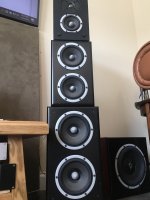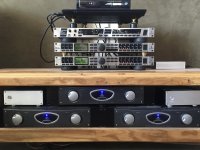Maybe it's not ideal to have the volume stuffed completely with felt (if I remember correctly)? Comparisons others have done show that damping "too much" reduces spl at the lower range of the spectrum (typically in a bass cabinet; but in principle that applies to the lower midrange as well).
Which may imply that the driver has to work against some sort of "flow resistance" at those frequencies - probably formed by the very dense stuffing inside ...
https://www.diyaudio.com/forums/att...stic-8055afb2-6f8e-48c6-a008-164c91178186-jpg
actual measurements show no loss of spl down to 200hz. In fact, it traces the raw peerless loudspeaker data perfectly. Remember that this is with the200 hz 48db crossover point included (note the 1db drop in output below 600hz on both traces)
https://www.diyaudio.com/forums/att...nd-panel-deadener-density-acoustic-830881-pdf
Last edited:
Well, "no loss" in relation to what exactly? The simplest point of reference would be how it measures without ANY felt, I think. And there I'd expect some reduction in spl in the lower range ... Not a "huge loss", but some 1 - 2 db maybe.actual measurements show no loss of spl down to 200hz.
However, I am not sure myself if that would be the best comparison.
But your description of how it sounds really could indicate some sort of "over dampening".
On the other hand, for high spl requirements it might be a good idea to NOT let such a smallish mid work as low as 200 Hz anyway.
Well..No. The 1db loss is exactly the same as on the raw peerless loudspeaker data, which shows that the 1db drop below 600hz is purely a natural characteristic of the driver itself and is not caused by an outside influence.
Good question.
Currently I tend to think about it like this: Below the first box mode there is no "colouration" occurring. At least not in a way that requires any absorption of sound energy inside the box.
So ideally(?) we would need to "kill" the modes from the lowest one upwards - but without the use of broadband(!) absorption which already is effective at significant lower frequencies (to some degree at least).
Currently I tend to think about it like this: Below the first box mode there is no "colouration" occurring. At least not in a way that requires any absorption of sound energy inside the box.
So ideally(?) we would need to "kill" the modes from the lowest one upwards - but without the use of broadband(!) absorption which already is effective at significant lower frequencies (to some degree at least).
Last edited:
Anyway, I think it would be an interesting attempt to measure and listen with (much) less internal absorption.
This project was specifically created to produce mid frequencies and up. If it cannot produce the lower midrange the way I want, that's perfectly fine with me, since that wasn't part of my original design goal.
Last edited:
My lower units are more than capable of doing lower mids..
http://www.madisound.com/pdf/peerless/830882.pdf
http://www.madisound.com/pdf/peerless/830882.pdf
Attachments
Last edited:
Crossing over at 500hz would help with the power handling anyway, no bad thing with three Behringer amps. Is it possible to have an over damped speaker with that much power driving it?
The mids and highs are actually being run off of 2 separate but identical B&O ICEpower amps. The Behringers are being used only on the midbass drivers and subs. Ten channels of amplification in total.
Attachments
Last edited:
Unlike most inexpensive class d amplifiers, the FR is flat up to around 48khz into 4ohms(My drivers are 8 ohms, so its actually up around 100khz), so the 96 khz behringer DSP isn't being wasted. the amp cases are by Ghent.
ICEpower 50ASX2SE Class D Audio Amplifier with Power Supply Module 2 x 50W
ICEpower 50ASX2SE Class D Audio Amplifier with Power Supply Module 2 x 50W
Last edited:
Still some problems with getting the right part for assembly of the left speaker. I obviously can't do any serious critical listening until that happens. I apologize for the delay.
I like your adventurous aproach, it seems to have paid off.
How is the noise floor on your system? How close to you have to get before you hear audible hiss?
How is the noise floor on your system? How close to you have to get before you hear audible hiss?
Barely discernable with my ear right up next to the tweeter or midrange. Same thing with the midbass and sub. At 4 inches away, I can hear nothing from any of the drivers.
B&O icepower THD+noise .003%
Behringer ultradrive THD+ noise .007%
Behringer A500-
Signal-to-Noise Ratio -100dB, unweighted, 20Hz - 20kHz
B&O icepower THD+noise .003%
Behringer ultradrive THD+ noise .007%
Behringer A500-
Signal-to-Noise Ratio -100dB, unweighted, 20Hz - 20kHz
This is a project I had in the back of my mind for years. The scariest thing about it is that after all the thought, money, and effort, the actual audible effects may be minimal(Or worse). You just never know until the critical listening part happens. Even with the best objective measurements on earth, it's always a totally subjective experience in the end. You'll either like it or love it, or you won't like it or even hate it. Only time will tell.
Listening to one speaker can obviously give some hints as to how it will sound in stereo, but just not enough to give a fair analysis, so I'm staying mum on the issue until that happens.
Be careful when checking the noise floor, once I had the volume turned right up after a CD had finished with my ear an inch from the speaker, when I sat down I discovered that there was a hidden track, I about #### myself, but I was well glad that I didn't still have my ear by the speaker. Jees.
I personally prefer initial voicing in summed mono on one speaker.
I agree completely with that. In fact, stereo can interfere with deciphering whether a speaker pair truly sounds “good” or not. Listening to one side in summed mono will expose it for what it is every time as long as a variety of music is listened to. At the same time though, stereo exposes things that mono just can’t, so having the option of going back and forth during final tuning is critical.
Last edited:
- Home
- Loudspeakers
- Multi-Way
- Midrange experiment with Auto sound panel deadener and high density acoustic felt..

